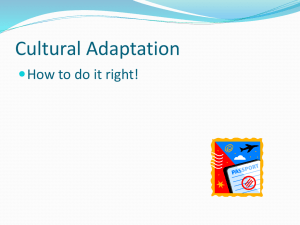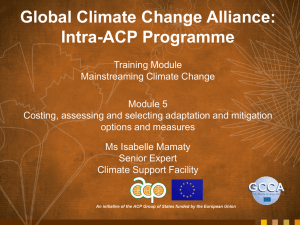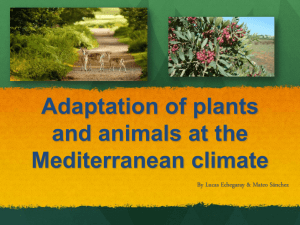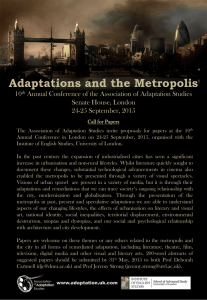Reviewing and appraising adaptation options - UNDP-ALM
advertisement
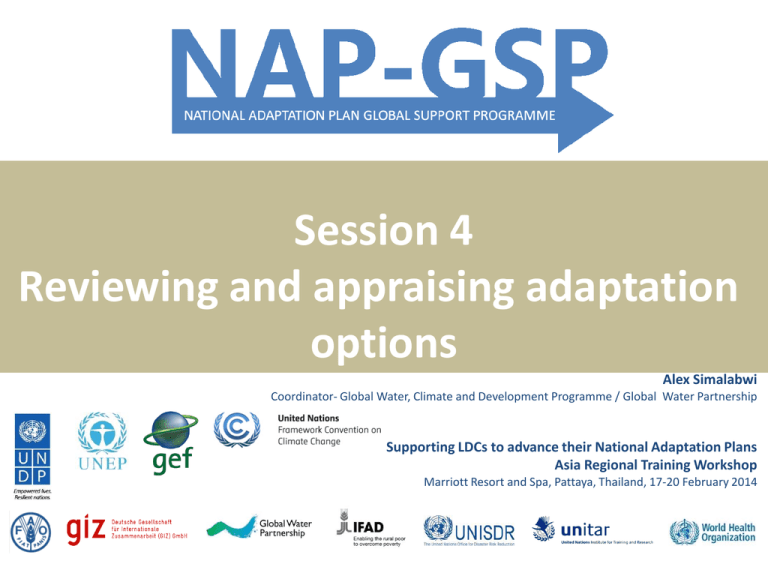
Session 4 Reviewing and appraising adaptation options Alex Simalabwi Coordinator- Global Water, Climate and Development Programme / Global Water Partnership Supporting LDCs to advance their National Adaptation Plans Asia Regional Training Workshop Marriott Resort and Spa, Pattaya, Thailand, 17-20 February 2014 Reviewing and appraising adaptation options Issues that need to be addressed when reviewing and appraising adaptation options, with an indication of a standard tools and criteria involved in making decisions about selecting adaptation options. Session 4 Reviewing and appraising adaptation options Supporting LDCs to advance their National Adaptation Plans Asia Regional Training Workshop GENERAL APPRAISAL PROCESS FOR INVESTMENT UNDER UNCERTAINTY General procesess for appraising adaptation investment options 1. Identify priority investment options 2. Select appropriate method to appraise adaptation investment options 3. Identify and measure investment returns and costs 4. Select robust adaptation investment option to implement 1 Identify priority adaptation investment options 2 3 4 Select appropriate investment appraisal method Identify and measure investment returns and costs Select robust adaptation investment option Case of Bhutan NAPA • • • • 17 adaptation options Screened to 9 options – Level of risk and adverse effects – Cost effectiveness – risk @do nothing scenario – Contribution to social-economic development MCA applied – Human life saved – Arable land saved – Infrastructure saved – Project cost Prioritisation of options-top 2 – Disaster management strategy – Artificial lowering of thorthomi glacier lake [Session number] [Session title] Supporting LDCs to advance their National Adaptation Plans Asia Regional Training Workshop Framework for Water Security and Climate Resilient Development Helps to identify and put in place investments that can withstand multiple climate scenariosNo/low Regret investments Framework for Water Security & Climate Resilient Development Strategic Framework process – Phase 2 OUTPUT Balanced portfolio of adaptation options and measures for risk reduction to existing assets and planned projects / programmes. Portfolio presents a strongly argued case for options using RDM to test resilience and economic appraisal techniques to ensure viability. Page 7 The Strategic Framework process – Phase 2 Identifying options to improve resilience of existing assets, ongoing or planned development activities Screening tool for climate risks Page 8 Strategic Framework process – Phase 2 TOOL – Screening tool for climate risks • Screening for climate risks Generic approach can be applied across sectors and scales Requires simple climate change scenarios Risk reduction; • • • • reduce uncertainty do things differently do different things bear the risks • Examples for screening; • Infrastructure development (e.g. energy, transport, agriculture), Water resources policies, projects and programmes • Urban planning policies and regulations Page 9 The Strategic Framework process – Phase 2 Stakeholder cross sector dialogue, partnerships to identify new opportunities adaptation Page 10 Strategic Framework process – Phase 2 Robust Decision Making (RDM) TOOL – Robust Decision Making (RDM) Process for making decisions under uncertainty Uses multiple scenarios of climate and development futures to ‘test’ performance of investment options (sensitivity analysis) No/low regrets investment options prioritised over climate risky investments Risk reduction measures promoted to deal with residual risks Page 11 Strategic Framework process – Phase 2 Make the case for priority options TOOLS – Benefit Cost Analysis (BCA), Cost Effectiveness (CE), Multi Criteria Analysis (MCA) Economic appraisal techniques are key to make the case for investment Estimating social and environmental costs is also important in ensuring decisions are equitable. An ecosystems approach can highlight ecosystems services Page 12 CHOOSE YOUR TOOL According to UNFCCC, decision making methods vary in terms of the objectivity of decision and the complexity of the problem. COST BENEFIT ANALYSIS Cost Benefit Analysis (CBA) is the most commonly used economic analysis for decision making due to its ‘simplicity’ in systematically comparing all the costs and benefits that are accrued from a project. COST EFFECTIVENESS ANALYSIS Cost Effectiveness Analysis (CEA) is an economic valuation to compare intervention options by comparing the gains to the costs of the intervention. It is not meant to be a sole evaluation tool -widely used in assessing intervention in health sector. In practice, CEA is often preferred when the benefits of investment project are difficult to measure in monetary terms. MULTICRITERIA ANALYSIS Multi-criteria analysis (MCA) is useful when there are a number of criteria that need to be taken into account rather than the focus on a single criterion, such as CBA and CEA. MCA can provide simple yet rich insight on key criteria and it can be graphically represented by mapping the distribution of the values of its criteria. This simple graphic representation illustrate the trade-offs between different criteria MCA techniques in general consist of two stages: 1. Weighting 2. Scoring A standard analysis of MCA includes a “Performance Matrix” or evaluation matric Framework for Climate Resilient Growth and Development At least 33 Ministers and their representatives witnessed the launch Towards a water supplement for NAPs Guidelines Primary focus is on Element B …. Water in the context of the NAP process 19 GWP/UNICEF: TOWARDS STRATEGIC FRAMEWORK FOR WASH AND CLIMATE RESILIENT DEVELOPMENT CONCLUSION In developing investment options, it is important to be aware level of risk or uncertainty, sources of this risk and uncertainty. For initial adaptation investment, priority should be on early and robust options, while if possible also address low-regret, long-lead options and options that avoid locking-in future vulnerability. Robust decision making concept- take into account uncertainty by assessing its performance under a wide range of uncertainty scenarios or by incorporating sensitivity analysis. Fit for purpose-methods have their own advantages, shortcomings and resource requirement. In practice, methods not necessarily mutually exclusive, can be modified or used in conjunction. For example, CBA can be used together with MCA for nonmonetary investment returns. SUPPORT AVAILABLE UNDP-GEF, USAID, GWP ECONOMICS OF ADAPTATION TRAINING INITIATIVE FOR AFRICA, ASIA AND PACIFIC ADDITIONAL INFORMATION AND ECONOMIC TOOLS AND METHODS COST BENEFIT ANALYSIS PROCEDURE (1) Cost Benefit Analysis (CBA) is the most commonly used economic analysis for decision making due to its ‘simplicity’ in systematically comparing all the costs and benefits that are accrued from a project. Steps in conducting CBA: 1. Specify adaptation investment options to be compared. 2. Define the lenses and scope of impacts. The lenses are the perspective of the decision makers who value the benefits and costs. The construction of highway with or without tol pricing option, for example, can be a cost or a benefit (revenue) depending on whose lenses. Ideally, the ‘lense’ to be used is of a “social welfare planner” who aims to maximise the net benefits of the society within the scope of analysis. A clear boundary definition of impact scope will also enhance the effectiveness of CBA by focusing on a system boundary upon which the impacts are estimated. COST BENEFIT ANALYSIS PROCEDURE (2) 3. Classify and assess the benefits and the costs. a. Determine measurement variables and quantify the impacts b. Determine valuation methods This step will draw on identification of returns and selection of valuation methods. It also requires defining a baseline upon which each investment option will be compared to. The baseline scenarion is normally called “Do Nothing” scenario. 4. Provide qualitative analysis of non-monetised impacts (optional). This step is an optional step and normally not conducted in traditional CBA. However it is important for investment in public sector in which some key impacts cannot be monetised. 5. Choose discount rate and calculate Net Present Value of investment options The stream of future costs and benefits in a project occur in different years. To compare future benefits and costs in one project to those in other projects, these future costs and benefits need to be discounted relative to the present values in order to obtain their present values. COST BENEFIT ANALYSIS PROCEDURE (3) 5. Choose discount rate and calculate Net Present Value of investment options. Discount rate: the interest rate that is used to discount future costs and benefits of a project. Net Present Value (NPV): the difference between the present values of future benefits and costs. NPV = Present Values of Future Benefits - Present Values of Future Costs The choice of discount rate is the most contentious aspect of using CBA. In practice, the discount rates might refer to those interest rates suggested by the relevant financial institution, e.g. 10-12% for World Bank and AfDB; For nationally funded projects, the discount rates might be different to those funded by multilateral development banks. COST BENEFIT ANALYSIS PROCEDURE (4) 6. Perform sensitivity analysis. In conducting CBA, there is always some degree of uncertainty regarding the magnitude of impacts or the value assigned to each impact. Sensitivity analysis is conducted to acknowledge this uncertainty and to inform decision makers of how and in what direction this uncertainty might affect the results on which alternative. Sensitivity analysis can be done using three approaches and the three of them can be conducted in each CBA Partial sensitivity analysis: it is conducted by varying one assumption at a time while holding the other assumptions constant. Worst and best scenario assumption: As these two scenarios are probably the ones decision makers are most concerned about, sensitivity analysis of the two scenarios provide extreme values that decision makers can prepare themselves for before making the decision. COST BENEFIT ANALYSIS PROCEDURE (5) 6. Perform sensitivity analysis. Monte Carlo simulation: uses random probability distribution of key numerical values to see if it affect the results. Calculate switching values of key parameters which values are not known with certainty. Switching values are the values of parameters that significantly change the results of CBA and the decision on which alternative yields highest net benefits. 7. Analyse the results and provide recommendation. DECISION RULE 1. A project (adaptation option) is feasible if NPV > 0 2. Choose project (adaptation option) with the greatest net benefit or Net Present Value (NPV) Notes: •Another decision rule that is commonly used is Benefit Cost Ratio (BCR) •BCR of a project should be greater than 1 •NPV criterion should take priority than BCR criterion as: • NPV focuses on the amount of net benefits rather than merely the ratio. This is in line with the objective of maximising net social benefit from the investments. • BCR is highly sensitive to how impacts are categorised as benefits or costs, while NPV does not face this problem. DECISION RULE - EXAMPLE Choosing among projects: NPV vs BCR Project Costs ($ million) Benefits ($ million) NPV ($ million) BCR ($ million) Do Nothing 0 0 0 - Project A 1 10 9 10 Project B 10 30 20 3 Project C 4 8 4 2 Project D 3 5 2 1.7 Project C & D 7 21 14 3 10 8 -2 0.8 Project E Source: Boardman et al (2000) Cost Benefit Analysis: Concepts and Practice TREATMENT OF UNCERTAINTY IN CBA Apart from using sensitivity analysis, the treatment to uncertainty in CBA can also be done by assessing how well each investment option work under a wide range of climate scenarios. Example: Tank Management in Kala Aya River Basin, Sri Lanka. Four investment options (“scenario” in this case) were identified. The results are as below. Reference: Russi et al., 2010 (Reference #5) COST EFFECTIVENESS ANALYSIS (1) Cost Effectiveness Analysis (CEA) is an economic valuation to compare intervention options by comparing the gains of objective (in appropriate unit) to the costs of the intervention. It is not meant to be a sole evaluation tool and it is widely used in assessing intervention in health sector. In practice, CEA is often preferred when the benefits of investment project are difficult to measure in monetary terms. McKinsey developed Economics of Climate Adaptation that use CEA method to produce adaptation cost curve (ACC) for each unit of benefit. The ACC is considered a novel approach in which a single criterion of non-monetary benefit can be used to a wide range of different adaptation investments. Nevertheless, this approach also contains flaws as the single criterion might overlook a number of important impacts. COST EFFECTIVENESS ANALYSIS (4) Example: Valuation of climate change impacts on human health Annual Cost per Case of Diarrhea Avoided with Water and Sanitation Programs 2000-2015 (US$, 2000) Source: Markandya 2009 (Reference#6) MULTICRITERIA ANALYSIS Multi-criteria analysis (MCA) is useful when there are a number of criteria that need to be taken into account rather than the focus on a single criterion, such as CBA and CEA. MCA can provide simple yet rich insight on key criteria and it can be graphically represented by mapping the distribution of the values of its criteria. This simple graphic representation illustrate the trade-offs between different criteria MCA techniques in general consist of two stages: 1. Weighting 2. Scoring A standard analysis of MCA includes a “Performance Matrix” or evaluation matric CAVEATS This lecture is only an introductory material for participants to be aware of various investment appraisal methods. Further study on relevant references and/or training specific to each investment appraisal method is required before participants can conduct the method independently and sufficiently in order to meet their needs in investment appraisal. There is no one single bullet method for investment appraisal that works well regardless of the circumstances. It is important to be aware of the characteristics, requirement, advantages and shortcoming of each method in relevance to the contexts being evaluated. Clear definition of the scope of analysis is crucial for the identification and measurement of investment returns and costs. Stakeholders inputs and participation in the appraisal process is also important to define the goal of the appraisal and the criteria upon which investment options are evaluated. Trade-offs among investment options and the distribution of benefits and costs among stakeholders also need to be taken into account in the decision making. WEB REFERENCES 1 • http://www.gwp.org/Documents/WACDEP/TBD_Final.pdf • http://www.gwp.org/en/WACDEP/RESOURCES/Technical-References/ • http://www.gwp.org/en/WACDEP/IMPLEMENTATION/Capacity-DevelopmentInitiative/ • http://www.undp-alm.org/projects/ecca • http://www.gwp.org/Global/Activities/News/November%202013/Third%20draft% 20of%20the%20Water%20Supplement%2011%20November%202013%20pdf.pdf REFERENCES (2) 1. 2. 3. 4. Water Security and Climate Resilient Development: Technical Background Document. http://www.gwp.org/Global/About%20GWP/Publications/CDKN%20publications/ TBD_Final.pdf Willows, R.I. and Connel, R.K. (Eds.). (2003) Climate Adaptation: Risk, uncertainty and decision making. UKCIP Technical Report. UKCIP, Oxford. http://www.ukcip.org.uk/wordpress/wp-content/PDFs/Risk.pdf Ranger, N., Millner, A., Dietz, S., Fankhauser, S., Lopez, A., and Ruta, G. (2010). Adaptation in the UK: a decision-making process. Policy Brief. Grantham Research Institute on Climate Change and the Environment. http://www.lse.ac.uk/GranthamInstitute/publications/Policy/docs/PB-Rangeradaptation-UK.pdf Fankhauser, S., Ranger, N., Colmer, J., Fisher, S., Surminski, S., Stainforth , D., and Williamson, A. (2013). An Independent National Adaptation Programme for England. http://www.lse.ac.uk/GranthamInstitute/publications/Policy/docs/PBindependent-national-adaptation-programme-for-england.pdf REFERENCES (3) 5. 6. 7. 8. Russi D., ten Brink P., Farmer A., Badura T., Coates D., Förster J., Kumar R. and Davidson N. (2013) The Economics of Ecosystems and Biodiversity for Water and Wetlands. IEEP, London and Brussels. http://www.teebtest.org/wpcontent/uploads/2013/04/TEEB_WaterWetlands_Report_2013.pdf Markandya, A. 2009. Valuing Climate Change Impacts on Human Health: Empirical Evidence from the Literature. International Journal of Environmental Research and Public Health, 6, 759-786. http://www.ncbi.nlm.nih.gov/pmc/articles/PMC2672348/pdf/ijerph-06-00759.pdf UK Department for Communities and Local Government. 2009. Multi-Criteria Analysis: A Manual. https://www.gov.uk/government/publications/multi-criteriaanalysis-manual-for-making-government-policy Okeola, O.G. and Sule, B.F. 2012. Evaluation of management alternatives for urban water supply system using Multicriteria Decision Analysis. Journal of King Saud University – Engineering Sciences , 24, 19–24. http://www.sciencedirect.com/science/article/pii/S1018363911000614 REFERENCES (4) 9. Mukheibir, Pierre (2005) Local water resource management strategies for adaptation to climate induced impacts in South Africa. http://www.erc.uct.ac.za/Research/publications/05Mukheibir_Local_water_resour ce_management.pdf






